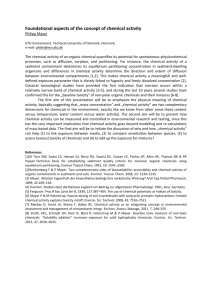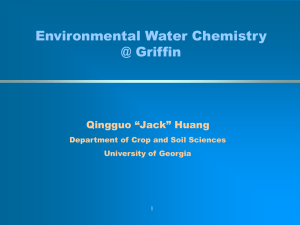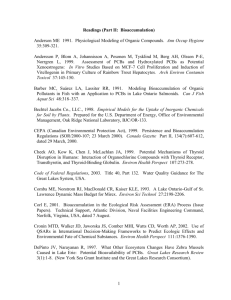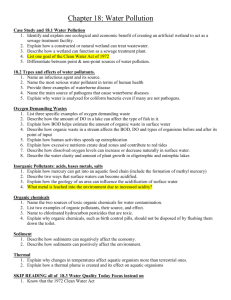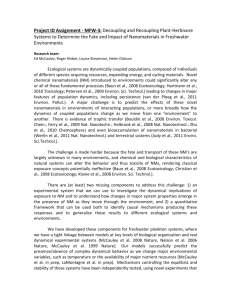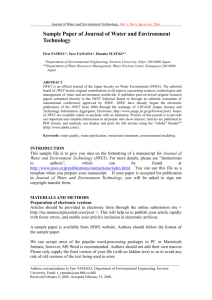REFERENCES
advertisement
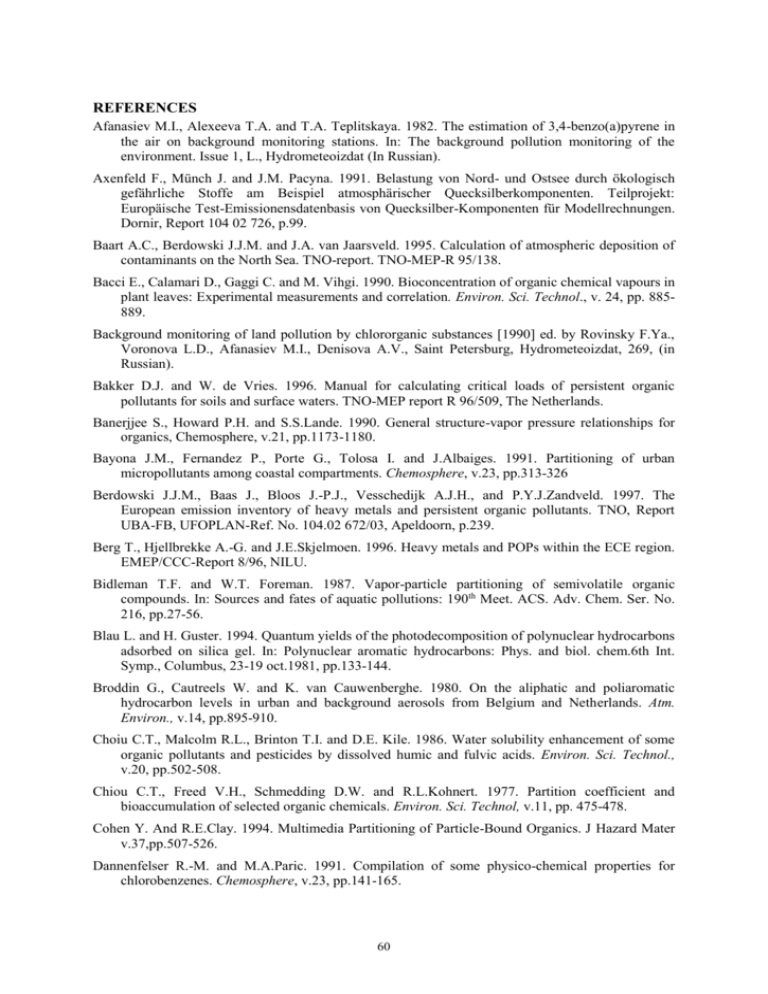
REFERENCES Afanasiev M.I., Alexeeva T.A. and T.A. Teplitskaya. 1982. The estimation of 3,4-benzo(a)pyrene in the air on background monitoring stations. In: The background pollution monitoring of the environment. Issue 1, L., Hydrometeoizdat (In Russian). Axenfeld F., Münch J. and J.M. Pacyna. 1991. Belastung von Nord- und Ostsee durch ökologisch gefährliche Stoffe am Beispiel atmosphärischer Quecksilberkomponenten. Teilprojekt: Europäische Test-Emissionensdatenbasis von Quecksilber-Komponenten für Modellrechnungen. Dornir, Report 104 02 726, p.99. Baart A.C., Berdowski J.J.M. and J.A. van Jaarsveld. 1995. Calculation of atmospheric deposition of contaminants on the North Sea. TNO-report. TNO-MEP-R 95/138. Bacci E., Calamari D., Gaggi C. and M. Vihgi. 1990. Bioconcentration of organic chemical vapours in plant leaves: Experimental measurements and correlation. Environ. Sci. Technol., v. 24, pp. 885889. Background monitoring of land pollution by chlororganic substances [1990] ed. by Rovinsky F.Ya., Voronova L.D., Afanasiev M.I., Denisova A.V., Saint Petersburg, Hydrometeoizdat, 269, (in Russian). Bakker D.J. and W. de Vries. 1996. Manual for calculating critical loads of persistent organic pollutants for soils and surface waters. TNO-MEP report R 96/509, The Netherlands. Banerjjee S., Howard P.H. and S.S.Lande. 1990. General structure-vapor pressure relationships for organics, Chemosphere, v.21, pp.1173-1180. Bayona J.M., Fernandez P., Porte G., Tolosa I. and J.Albaiges. 1991. Partitioning of urban micropollutants among coastal compartments. Chemosphere, v.23, pp.313-326 Berdowski J.J.M., Baas J., Bloos J.-P.J., Vesschedijk A.J.H., and P.Y.J.Zandveld. 1997. The European emission inventory of heavy metals and persistent organic pollutants. TNO, Report UBA-FB, UFOPLAN-Ref. No. 104.02 672/03, Apeldoorn, p.239. Berg T., Hjellbrekke A.-G. and J.E.Skjelmoen. 1996. Heavy metals and POPs within the ECE region. EMEP/CCC-Report 8/96, NILU. Bidleman T.F. and W.T. Foreman. 1987. Vapor-particle partitioning of semivolatile organic compounds. In: Sources and fates of aquatic pollutions: 190th Meet. ACS. Adv. Chem. Ser. No. 216, pp.27-56. Blau L. and H. Guster. 1994. Quantum yields of the photodecomposition of polynuclear hydrocarbons adsorbed on silica gel. In: Polynuclear aromatic hydrocarbons: Phys. and biol. chem.6th Int. Symp., Columbus, 23-19 oct.1981, pp.133-144. Broddin G., Cautreels W. and K. van Cauwenberghe. 1980. On the aliphatic and poliaromatic hydrocarbon levels in urban and background aerosols from Belgium and Netherlands. Atm. Environ., v.14, pp.895-910. Choiu C.T., Malcolm R.L., Brinton T.I. and D.E. Kile. 1986. Water solubility enhancement of some organic pollutants and pesticides by dissolved humic and fulvic acids. Environ. Sci. Technol., v.20, pp.502-508. Chiou C.T., Freed V.H., Schmedding D.W. and R.L.Kohnert. 1977. Partition coefficient and bioaccumulation of selected organic chemicals. Environ. Sci. Technol, v.11, pp. 475-478. Cohen Y. And R.E.Clay. 1994. Multimedia Partitioning of Particle-Bound Organics. J Hazard Mater v.37,pp.507-526. Dannenfelser R.-M. and M.A.Paric. 1991. Compilation of some physico-chemical properties for chlorobenzenes. Chemosphere, v.23, pp.141-165. 60 Doucette W.J. and A.W.Andren. 1988. Aqueous solubility of selected biphenyl, furan and dioxin congeners. Chemosphere, v.17, pp.243-252. Dunnivant F.M. and A.M.Elzerman. 1988. Aqueous solubility and Henry`s low constants for PCB Congeners for evaluation of quantitative structure-property relationships (QSPRs). Chemosphere, v.17. pp. 525-541. Elder D.L. and J.P.Villeneuve. 1977. Polychlorinated biphenyls in the Mediterranean Sea. Mar. Pollut. Bull. v.8, pp.19-22. Ellington J.J., Stancil F.E., Payne W.D. and C.D. Trusty. 1987. Measurements of hydrolysis rate constants for evaluation of hazardous waste land disposal. U.S. EPA Report 600/3-87/019. Estimating exposure to dioxin-like compounds. 1994. EPA/600/6-88/005/Cb. Washington v.II, pp.5-9. Finlayson-Pitts B.J. and J.N.Jr. Pitts. 1986. Atmospheric chemistry: Fundamentals and experimental techniques. Willy, New York. Finizio A., D.Mackay, T.Bidleman, T.Harner .1997. Octanol-air partition coefficient as a predictor of partitioning of semi-volatile organic chemicals to aerosols. Atmos. Environ., v.31, pp.2289-2296. Fischer R. and Z. Fresenins. 1989. Anal.Chem., v.333, pp.731-737. Fowler S.W. 1985. Assessing pollution in the Mediterranean Sea. In: Pollutants and their ecotoxicological significance, H.W.Nurnberg (Ed.) Ch.19, John Wiley and Sons Ltd., pp.277282. Fowler S.W. 1986. PCBs and the environment. The Mediterranean marine ecosystem. In: PCBs and the environment, J.S.Waid (Ed.) v.3, Ch.8, CRC Press Inc., Boca Raton, F1, pp.209-239. Garcia Luz M., C. Porte, J. Albaiges. 2000. Organochlorinated pollutants and xenobiotic metabolizing enzymes in the W. Mediterranean mesopelagic fish. Marine Pollution Bulletin, v.40. No.9, pp.764-768. Geiss A. and J.Bourdeaux. 1986. Analitical chemistry of PCBs. Butterwarth Stoneham., Mass, USA. Gruzdev G.S. 1987. Plants chemical protection. М., Agropromizdat. (in Russian) Haque R. and D.W.Schmedding. 1975. A method of measuring the water solubilities of hydrophobic chemicals: solubilities of five chlorinated biphenyls. Bull. Environ. Contam. Toxicol., v.14, pp.13-18. Harner T., Mackay D. and K.C. Jones. 1995. Model of the long-term exchange of PCBs between soil and the atmosphere in the southern UK. Environ. Sci. Technol, v.29, pp. 1200-1209. Harner T. and T.F.Bidleman. 1998. Octanol-air partition coefficient for describing particle/gas partitioning of aromatic compounds in urban air. Environ. Sci. Technol., v.32, pp.1494-1502. Harner T. and T.F. Bidleman. 1996. Measurements of octanol-air partition coefficients for polychlorinated biphenyls. Chem. Eng. Data , v.41, pp.895-899. Harvey R.G. 1991. Polycyclic aromatic hydrocarbons: chemistry and carcinogenicity. Cambridge University Press, Cambridge. Hernandez F., R. Serrano, A.F. Roig-Navarro, Y. Martinez-Bravo, F.J. Lopez. 2000. Persistent organochlorines and organophosphorus compounds and heavy elements in common whale (Balaenoptera physalus) from the Western Mediterranean Sea. Marine Pollution Bulletin, v.40, No.5, pp.426-433. Hincley D.A., Bidleman T.F., and Foreman W.T. 1990 Determination of vapor pressure for nonpolar and semipolar organic compounds from gas chromatographic retention data. Jornal of Chemical and Engineering Data v.35, No.3, pp.232-237 Holoubek I., Caslavsky J. and L.Nondek. 1993. Methodologies for the estimation of the emission of persistent organic pollutants to the atmosphere (a Guidebook). 61 Holtslag A.A.M. and A.P. van Ulden. 1983. A simple scheme for daytime estimates of the surface fluxes from routine weather data. Climate Appl. Meteor., v.22, pp.517-529. Horzempa L.M. and D.M. DiToro. 1983. The extend of reversibility of polychlorinated biphenyl adsorption. Water Res., v.17, pp. 851-859. van den Hout K.D. Ed. 1994. The impact of atmospheric deposition of non-acidifying pollutants on the quality of European forest soils and the North Sea. Main report of the ESQUAD project. National Institute of Public Health and Environmental Protection (RIVM) rep.722401003, IMWTNO rep.R93/329. Howard P.H. 1991. Handbook of environmental fate and exposure data for organic chemicals, Pecticides, v.III, Lewis Publishers Inc., Chelsea, Michigan. ten Hulscher Th.E.M., L.E van der Velde and W.A. Bruggeman. 1992. Temperature Dependence of Henry’s Law Constants for Selected Chlorobenzenes, Polychlorinated Biphenyls and Polycyclic Aromatic Hydrocarbons. Environ. Toxicol. Chem., v.11, pp.1595-1603. Isnard P. and S.Lambert. 1988. Estimating bioconcentration factors from octanol-water partition coefficients. Chemosphere, v.17, pp.31-34. Izrael Yu.A. and A.V.Tsyban. 1989. Anthropogenic ecology of the ocean, Leningrad, Russia, Hydrometizdat. Jacobs C.M.J and W.A.J. van Pul. 1996. Long-range atmospheric transport of persistent organic pollutants. Description of surface-atmospheric exchange modules and implementation in EUROS, National Institute of Public Health and Environmental Protection (RIVM) report 722401013. Jeftic L., Bernhard M., Demetropoulos A., Fernex F. and G.P.Gabrielides. 1989. State of the Mediterranean marine environment. MAP Technical Reports Series No.28. UNEP, Athens. Junge C.E. 1977. Basic considerations about trace constituent in the atmosphere is related to the fate of global pollutant. In: Fate of pollutants in the air and water environment. Part I, I.H. Suffer (ed.) (Advanced in environmental science and technology, v.8), Wiley-Interscience, New York. Karikhoff S.W. 1981. Semiempirical estimation of sorption of hydrophobic pollutants on natural sediments and soils. Chemosphere, v. 10, pp. 833-846. Karikhoff S.W., Brown D.S. and T.A.Scott. 1979. Sorption of hydrophobic pollutants on natural waters. Water Res., v.13, pp.241-248. Kenaga E.E. and C.A.I. Goring. 1980. Relationship between water solubility, soil sorption, octanolwater partitioning, and concentration of chemicals in biota. In: Aquatic Toxicology. Eds: Eaton J.G., Parrish P.R. and A.C.Hendricks, ASTM, Philadelphia, PA, pp.78-115. Kononiuk V.F. 1986. About destruction of pesticides in the environment. In: The use and protection of nature water, Мoscow, pp. 47-54 (in Russian). Korte F. 1996. Ecological Chemistry. Moscow, Mir, p.396 (in Russian). Kucklik J.R., Hinckley D.A. and T.F.Bidleman. 1991. Determination of Henry’s low constants for hexachlorocyclohexanes in distilled water and artificial sea water as a function of temperature. Mar. Chem., v.34. pp.197-209. Kushi M., Kogure N. and Y.Hashimoto. 1990. Contribution of soil constituents in adsorption coefficient of aromatic compounds, halogenated polycyclic and aromatic compounds to soil. Chemosphere, v.21, pp.867-876. Laskovski D.A., Swan R.L., McCall P.J., Bidlack H.D. and H.J.Dishburger. 1984. Characteristics of soil degradation studies for predicting pesticide behavior. In: Prediction of pesticide behaviour in the environment. Proc. of USA_USSR Symposium, Erevan. EPA-600/9-84-026. Athens, Georgia, USA, pp.90-101. 62 Lindane. 1983. Centre of International Projects, State Committee of Science and Technology, No.40. Ed. by Izmerov, p.14 (in Russian). Lyman W.J. (Ed.). 1982. Handbook of chemical properties estimation methods- environmental behavior of organic compounds. New York, McGraw-Hill Book Co., Inc. Mackay D. and S.Paterson. 1991. Evaluating the fate of organic chemicals: a level III fugacity model. Environ. Sci. Technol, v.25, pp. 427-436. Mackay D. and W.Y.Shiu. 1984. A critical review of Henry’s low constants for chemicals of environmental interest. Phys. Chem. Ref. Data, v.4, pp.1175-1179. Mackay D., Shiu W.Y. and K.C.Ma. 1992. Illustrated handbook of physical-chemical properties and environmental fate for organic chemicals. CRC. Press. Boca Raton, FL., vol. II. Mackay D. and F.Wania. 1995. Transport of contaminants to the Arctic: partitioning, processes and models. Sci. Total Environ., v.160/161, pp. 25-38. Maistrenko V.N., Khamitov R.Z. and G.K.Budinkov. 1996. Ecological-analytical monitoring of supertoxic substances. Moscow. Chemistry, p.319 (in Russian). Miller M.M., Ghodbane S., Wasik S.P., Tewari Y.B. and D.E.Martire. 1984. Aqueous solubilities, octanol-water partitioning coefficients, and entropies of wetting of chlorinated benzenes and biphenyls. Chem. Eng. Data, v.29, pp. 84-190. Mill T., Mabey W.R., Lan B.Y. and A. Baraze. 1981. Photolysis of polycyclic aromatic hydrocarbons in water. Chemosphere, v.10, pp. 1281-1290. Murphy T.J., Mullin M.D. and J.A.Meyer. 1987. Equilibration of polychlorinated biphenyls and toxaphen with air and water. Environ. Sci. Technol, v.21, pp. 155-162. Opperhuizen A., Gobas F.P.C. and J.M.D.van der Steen. 1988. Aqueous solubility of polychlorinated biphenyls related to molecular structure. Environ. Sci. Technol, v.22, pp. 638-646. Pal D., Weber J.B. and M.R.Overcash. 1980. Fate of polychlorinated biphenyls (PCBs) in soil-plant systems. Residue Reviews, v. 74, pp. 45-98. Pekar M. 1996. Regional models LPMOD and ASIMD. Algorithms, parametrization and results of application to Pb and Cd in Europe scale for 1990. Meteorological Synthesizing Centre - East Report 9/96, September. Pekar M., Gusev A., Pavlova N., Strukov B., Erdman L., Ilyin I. and S.Dutchak. 1998. Long-range transport of selected POPs. Development of transport models for lindane, polychlorinated biphenyls, benzo(a)pyrene. EMEP/MSC-E Report 2/98, Part I. Picer N. and M.Picer. 1979. Monitoring of chlorinated hydrocarbons in water and sediments of the North Adriatic coastal waters. Etud. Pollut. CIESM, v.4, pp.133-136. Progress report of 4th International Conference on the Protection of the North Sea. 1995. Esbjerg, Denmark, 8-9 June. Purmal A. 1997. Chemical transformations of lindane in the atmosphere. Meteorological Synthesizing Centre - East Technical note 10/97, June. Revich B., Gurvich E., Prokopenko Yu. and B.Prokhorov. 1995. Eurasia. Regional and local problems of chemical pollution of the environment and population health, v.1, Moscow, p.203 (in Russian). Risby T.H., Hsu T.-B., Sehnert S.S. and P.Bhan. 1990. Physico-chemical properties of individual hexachlorobiphenils congeners. Environ. Sci. Technol, v. 24, pp. 168-187. Risebrough R.W., de Lappe B.W. and T.T.Schmidt. 1976. Bioaccumulation factors of chlorinated hydrocarbons between mussels and seawater. Mar. Pollut. Bull., v.7, pp.225-228. 63 Rovinsky F.Ya., Afanasiev M.I., Buivolov Yu.A. etc. 1992. J.of Ecological Chemistry, v.1, pp.46-64 (in Russian). Rovinsky F.Ya., Teplitzkaia Т.А. and T.A.Alekseeva. 1988. Background monitoring of PAH. Leningrad, Hydrometeoizdat (in Russian). Rovinsky F.Ya., Afanasiev M.I. and N.K. Vulih [1987] Background concentration of chloro-organic compounds and 3,4 benzo(a)pyrene in natural compartments (according to world data). Report 1,2,3,4. Monimong of backgroud pollution. L., Hydrometeoizdat, (in Russian). Schreitmüller J., Ballschmiter and K. Fresenius. 1994. Anal.Chem., v.348, pp.226-239. Schwarzenbach R.P., Gschwend P.M., Imboden D.M. 1993. Enviromental organic chemistry. John Wiley&Sons Inc., New York. Shilina A.I., Vaneeva L.V., and A.V. Zhuravleva. 1980. Benzo(a)pyren life time in the soil at its application with soil dust particles. In: Pollutions migration in soils and boundary media. II Allunion Meeting Proceedings, Obninsk, pp. 100-105 (in Russian) Shiu W.Y. and D.Mackay. 1986. A critical review of aqueous solibulities, vapor pressures, Henry`s low constants and octanol-water partitioning coefficients of the polychlorinated biphenyls. Phys. Chem. Ref. Data, v.15, pp.911-935. Strachan W.M.J. and H.J. Huneanet. 1979. Great Lakes Res., v.5, No.1, pp.61-68. Strand A. and O. Hov. 1996. A model Strategy for the Simulation of Chlorinated Hydrocarbon Distribution in the Global Environment. Water, Air and Soil Pollution, v.86, pp.283-316. Storelli M.M. and G.O. Marcotrigiano. 2000. Persistent Organochlorine residues in Risso’s Dolphins (Grambus griseus) from the Mediterranean Sea (Italy). Marine Pollution Bulletin, v.40, No.6, pp.555-558. Tanabe S. 1986. Distribution, behaviour and fate of PCB in the marine environment. J. of the Oceanological Soc. of Japan, v.41, No.5 (in Japan). Tolosa I., Bayona J.M. and J.Albaiges. 1995. Spatial and temporal distribution, fluxes and budgets of organochlorinated compounds in north-west Mediterranean sediments. Environ. Sci Technol., v.29, p.2519. Tonkopiy N.I., Shestopavlova G.E. and V.Ya.Rozanova. 1979. Some facts determining benzo(a)pyren degradation in soils. In: Cancerogenic substances in the environment. M., pp. 65-68. (In Russian). Tzukerman V.G. 1985. Modeling of HCH isomers and simazin behavior in different types of Kazakh SSR soils. In: Pollutions migration in soils and boundary environments. Proceedings of IV Allunion Meeting, Obninsk, 1983. Leningrad, Russia. Hydrometeoizdat, pp. 31-35, (in Russian). van Ulden A.P. and A.A.M. Holtslag. 1985. Estimation of atmospheric boundary layer parameters for diffusion applications. Climate Appl. Meteor., v.24, pp.1196-1207. UN Environmental Program. International register of potentially toxic chemicals. Benzo(a)pyrene. Centre of international projects. State Committee of Science and Technology, Moscow 1993. UNEP/FAO/WHO/IAEA. 1989. Assessment of the state of pollution of the Mediterranean Sea by organohalogen compounds and proposed measures (UNEP (OCA)/MED WG.3/Inf.6), Athens. UNEP. 1996. The state of the marine and coastal environment in the Mediterranean region. MAP TRS No.100, pp.46-48. Venkataraman C. and S.K.Friedlander. 1994. Size distributions of polycyclic aromatic hydrocarbons and elemental carbon. 2. Ambient Measurements and Effects of Atmospheric Processes. Environ. Sci. Technol., v. 28, pp. 563-572, 64 Vozhzennikov О.I., Bulgakov A.A., Popov V.E. Lukoyanov N.F., Naidenov A.V. Burkov A.J. Kutnyakov J.V. and V.G.Zhirnov. 1997. Review of migration and transformation parameters of selected POPs, EMEP/ Meteorological Synthesizing Centre - East Report 3/97. Wania F. 1997. Modelling area-air exchange of persistent organic pollutants: focus on temperature and other seasonal parameters. In: Sea-air exchange: processes and modelling. Ed. by J.M.Pacyna, D.Broman and E.Lipiatou 1998, pp. 161-190 Wania F. and D.Mackay. 1995. A global distribution model for persistent organic chemicals. The Science of the Total Environment, v.160/161, pp.211-232. Wania F. and D.Mackay. 1996. Tracking the distribution of persistent organic pollutants. Environ. Sci. Technol., v.30, No.9, pp.390A-396A. Wania F., Shiu W.Y. and D.Mackay. 1994. Measurement of the vapor pressure of several low volatility organochlorine chemicals at low temperature with gas saturation method. Chem. Eng. Data, v.39, pp.572-577. Wells D.E. and S.J.Johnstone. 1978. The occurrence of organochlorine residues in rainwater. Water, Air and Soil Pollution, v.9, pp.271-280. Whitehouse B.G. 1984. The effect of temperature and salinity on the aqueous solubility of polinuclear aromatic hydrocarbons. Marine Chemistry, v. 14, pp.319-332. WMO. 1997. Report and proceedings of the workshop on the assessment of EMEP activities concerning heavy metals and persistent organic pollutants and their further development (Moscow, Russia, 24-26 September 1996). WMO/TD No.806. Wodarg D. and K.H.Reinhardt. 1992. Untersuchung und Bewertung des Stoffeintrags in die Atmosphäre im Rahmen von PARCOM (Nordsee) und HELCOM (Ostsee): Teilbericht-Eintrag von organischen Spurenstoffen. Yalkowsky S.H., Valvani S.C. and D.Mackay. 1983. Estimation of the aqueous solubility of some aromatic compounds. Residue Reviews, 1983, v.85, pp.43-55. Yufit S.S. and N.A.Klyuev. 1997. Analytical review of physical-chemical processes responsible for persistent xenobiotics input to and removal from the atmosphere, Moscow (in Russian). 65
